Who pulled the plug?
I once heard somewhere that Westernport Bay is one of the fastest emptying bays in the world. Now whether or not that is true, from my experience, I tend to believe it. You only have to see the white water and rapids gushing past the pylons of the San Remo Bridge on an outgoing tide- it pumps out with great force to the ocean!
Westernport Bay is the second biggest bay in Victoria, the first being Port Phillip. At high tide the bay’s waters cover 680 sq km and at low tide the bay drains to expose 270 sq km of intertidal mudflats, mangroves and seagrass beds. Westernport has tidal variations which can fluctuate by up to 3 metres.
Westernport Bay has two entrances to Bass Strait: the Eastern Entrance and the Western entrance. The Eastern entrance goes out under the San Remo Bridge through Cleeland Bite with San Remo on one side, and Cape Woolamai on the other. It has a short bar, which can be tricky if there’s wind coming in against the direction of the tide. I once witnessed the waves standing up 6-10 ft high over the bar at the entrance! There are also large sand bars to avoid on the left as you go out, so be sure to take note of the channel markers.
The Western entrance goes out past Cowes, between the Nobbies and the western head of Flinders. The bar can be quite dangerous as it is subject to ocean swells and is exposed in all wind directions. This is a much longer bar of around 18 kilometres and is the main sea route to Hastings.
The two major islands of Westernport are Phillip Island and French Island. Westernport is broken into three main areas of fishing, the Northern, Eastern and Western Arms. There are also three Marine National Parks, Churchill Island, French Island and Yaringa. Keep a close eye on the boundaries as big penalties apply for fishing the wrong areas.

Westernport Bay Map
Variety is the spice of life
Westernport has something to offer all year round, so don’t be put off by the large tidal range and flow. A bit of prior research, map reading and assistance from tackle shops, as well as from other local fishers, will all hold you in good stead.
The waters of Westernport are teeming with more than 100 species of fish. Species include Snapper, Gummy, other Sharks, King George Whiting, Calamari, Flathead, Salmon, Mulloway, Trevally, Elephant Fish, Leather Jacket , Couta, Garfish, Pike and Mullet… just to name a few!
My most unusual catches so far have been an 81cm flathead, Westernport Slipper Bugs (like a Moreton Bay bug) and my partner Terry has caught a Wobbegong in Westernport. My favourite catch has been a kingfish in the bay.
The cooler months are more prolific for sharks and salmon, with the warmer months known for snapper and larger calamari. Whiting and flathead are all year round targets.
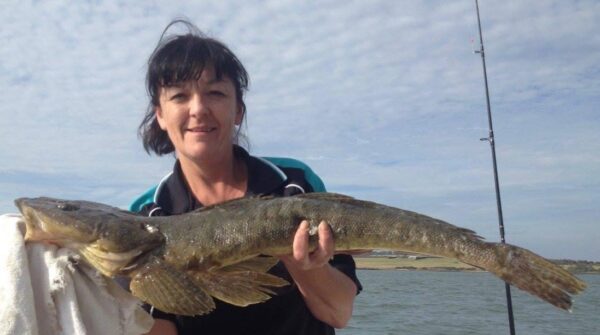
Amanda’s 81cm flathead
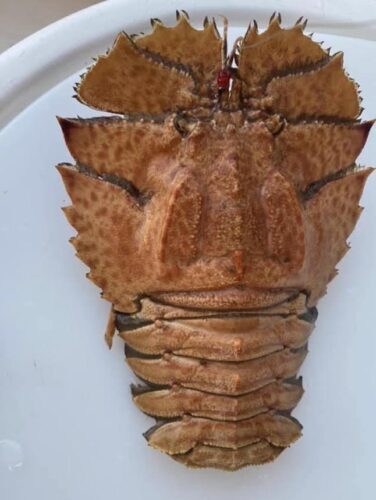
Westernport Slipper Bug
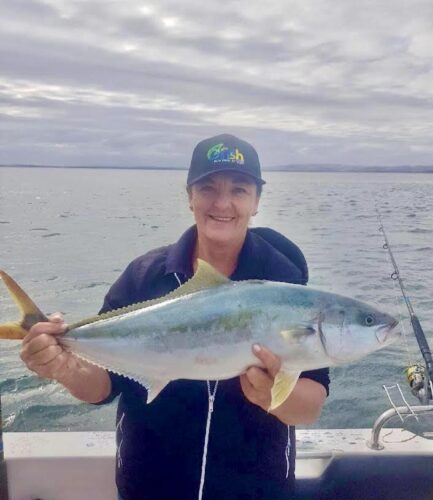
Amanda kingfish capture
Dirty old Westernport
The waters of Westernport can be quite dirty and brown at times, especially after a good downpour of rain, due to its many feeder estuaries like the Bunyip, Lang Lang and Bass Rivers. Some species, like snapper and mulloway don’t seem to mind the dirty water, so don’t be deterred! If you’re prepared to travel around a bit though, you can usually find some cleaner water.
Westernport has lots of changing depths and contours. There are hidden sandbars, muddy banks and rocky areas, which is where a good sounder and GPS plotter comes into play. Imagine back in my grandfather’s day when he was professionally fishing on Westernport- there was only the anchor, guesswork and memory! Our sounders even show the type of bottom, for example sandy or rocky, but back in the day you had to put the anchor down, pull it back up and if it was covered in mud, you were fishing in the mud!
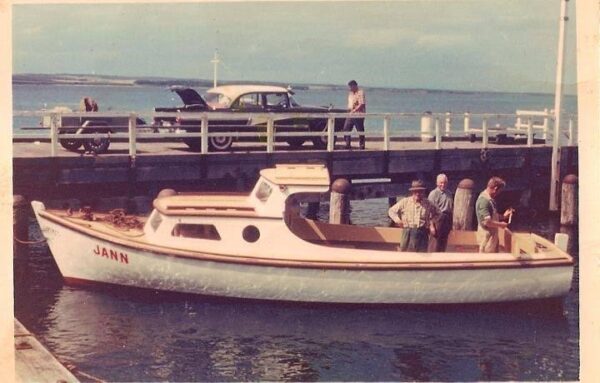
Amanda’s grandfather commercial fishing boat
Keep up with the tide!
With the stronger currents, you need a lot heavier gear than in Port Phillip Bay. You’ll also often have to up your sinker size as the tide flow increases. My local tackle shop, Jims Bait and Tackle in San Remo, suggest the general rule of thumb would be use sinkers ½ oz to 3oz when fishing the shallow areas of the bay. When you are chasing snapper or gummies you will need 4oz to 8oz in the shallower spots and 8oz to 16oz in the deeper channels.
You can of course move up or down in sinker size depending on the time of the tide, from slack to peak. Fishing with braid or mono will also make a difference to the weight of the sinkers you will need. Some anglers also prefer to use an Ezy Rig set up.
Fishing the slack tide can be quieter, but it’s still worth having a line in the water. The old adage of ‘no run, no fun or no flow, no go’ does apply though, so more movement in the water, will equal more movement of fish!
Choosing your fishing location
Building up GPS spots and favourite marks takes time as you slowly build your knowledge and library of ‘secret spots’. There are some great fishing Westernport maps available with GPS marks to start out with, available from your local tackle shop. They even list the species you can expect to catch at those spots.
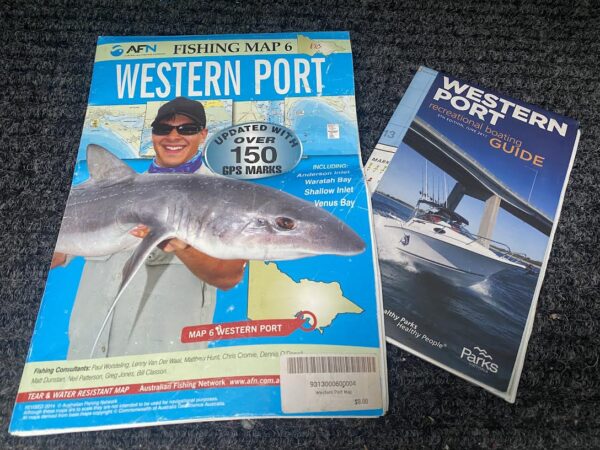
Westernport Bay maps
Westernport has so many nuances to discover- deep channels, gutters, reefy areas, weedy areas, mud flats, sand flats and patches, weed beds, humps and bumps. It takes time to discover what each area’s features are and what fish like those features!
Fishing the edges of channels for example, is where you might find gummies as they wait to intercept prey coming through. Weed beds can hold calamari and sand patches whiting. Knowing the time of year and water temps can assist with locating where the Snapper may be hiding as they spawn. Are they up on the mud flats in the shallows because it’s warmer? Westernport truly is an exciting puzzle for the angler to solve!
Some areas to get started
Dickies Bay
Found on the eastern side of the San Remo Bridge behind the police station. It’s a favoured spot for targeting whiting, with a mixture of weed beds and sand patches. Fish into the sand patches with a cocktail of pipi and a strip of squid or a small square of blue bait. We have used mussels successfully too. You can use small circle hooks (we use size 6 wide gaps) or long shanks (we use size 6). You can also buy handy whiting Snatcher pre rigs that you just tie on and add a sinker.
You can also get calamari across this end of the bay, so a squid jig floating out the back or a fish under a float can be used to target them at the same time. Garfish are available in this area too, and you can make your own rigs with a size 12 long shank hook under a float or buy premade gar rigs. Bread dough or Silverfish, bluebait and tiny strips of squid all make great baits.
Maggie Shoal and the Anderson Peg
Another 1km or so further ENE. Slightly deeper, but also good for whiting and squid. Look around on a nice sunny day and mark sand patches on your sounder so you can revisit them on cloudy days!
Reef Island
When you leave the Bass area and head towards Coronet Bay, you will come across Reef Island. A popular spot for whiting, squid and rock flathead. This is a rocky area, so keep an eye out as they can be hiding just under the water.
Leolia Shoals
Half a kilometre from Reef Island, look for the two hazard markers, this is a great for whiting, flathead and gummies.

Amanda’s night time Gummy Shark capture
The Corals
This area is located level with Observation Point, which is about 3km from the Rhyll Boat Ramp. If you were heading from Corinella, you pass Elizabeth Island and head towards Rhyll and about halfway you come across the Corals. The bottom is mostly reef and old oyster beds, with a mix of mud and weed thrown in. There’s lots of structure and drop offs.
This is a renowned area for big snapper at the right time of year, along with nice gummy and school sharks. I recommend anywhere between a 4oz to 8oz sinker depending on the flow, as it doesn’t flow as hard as other areas of Westernport. When we have done well on the snapper in this area we have marked the sounder with the time of year too, e.g. “early Oct snap” or “late Sept snap”. We will sound across old marks to see if they are holding any fish before dropping the anchor.

Amanda’s Snapper catch
The Main Channel near Elizabeth Island
We mostly fish this channel when it’s not running too hard. It’s a lot deeper water so an 8oz to 12oz sinker should be used on your bigger rods. We get big ‘channel’ whiting (King George) here using up to a 4oz sinker and big snapper and shark. If a 4oz wont hold bottom on the whiting rods, we move as that’s the sign it’s running too hard. You can also fish the edges of the channel either side and that includes nearby Gardiners Channel that is renowned for whiting.
Tortoise Head and Ram Island
Situated at the Cowes end of French Island, these areas can also be productive for whiting, squid, gummy and snapper.
The Elephant Triangle
Around May each year there is an influx of Elephant Sharks to an area described as the ‘triangle’. It runs northwest from Newhaven to Tortoise Head, east to Corinella and then southwest to Newhaven. Whilst freaky looking and fun to catch they aren’t great to eat, and only have a bag limit of one as they are dwindling in numbers. Therefore they are less a targeted species and more a surprise bycatch.
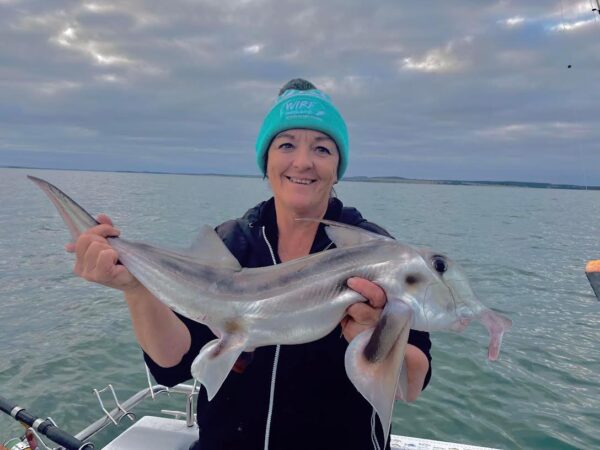
Amanda’s Elephant Shark
Cleeland Bight
Head under the San Remo Bridge towards the Eastern Entrance and you enter Cleeland Bight. There are lots of different fishing spots within the Bight.
Along the weed beds in about 2.5 metres of water out from the sand hill and boat moorings, you can pick up great squid either with squid jigs or fish under a float. Some anglers drift for them in the boat if the wind and tide are right. Some anchor and jig for the squid and others fish off the beach.
There are several good spots for whiting near the sandbar as you come out from the San Remo Jetty, in the sand patches along the beach side of Woolamai and in the deep near some of the markers. Also out from the sand hill only a few hundred metres from the beach.
You can pick up great rock flathead down near the old quarry right near the entrance. There’s also a mixed bag of species, pinkies, gummy, whiting and other bycatch to be had near the second channel marker as you head out the bight from the jetty. The Bight is renowned for wire weed in areas which is very snaggy, so you’ll need to pick your fishing spot carefully!

Amanda’s giant Southern Calamari
Other areas of Westernport
There is so much to explore, so grab that Westernport Map and check out places like Corinella, Tenby Point, Tooradin, Stony Point, Rhyll,Cowes, Silverleaves, Red Rocks, Eagle Rock, Joes Island, Crawfish Rock, the North Arm….the list goes on!
Boating on the Bay
Westernport has many boat ramps to choose from: Blind Bight, Corinella, Cowes, Flinders, Grantville, Hastings, Lang Lang, Newhaven, Rhyll, Shoreham, Stony Point, Tooradin and Warneet.
Westernport can get very choppy and it does change quickly, so research the day’s weather, wind predictions and tides before launching. Using the Boating Vic website or downloading the Boating Vic app can help show you important weather information and forecasts. Gusts can be up to 40% stronger than predicted and wave heights can be twice the size, so know your limits and be prepared!
A VHF marine radio can provide you with weather warnings while on the water and has designated radio channels for distress calling. Although not mandatory in enclosed waters, an EPIRB is recommended.
If you can position your boat somewhere where the wind and tide are going in the same direction, this will be the safest and most comfortable spot to fish. Sometimes it can be very testing whilst at anchor waiting for your boat to turn with the tide. In this situation you’re better off only having one line in the water to keep your bait presented cleanly and of course, to avoid tangles.
Landbased Fishing
There are plenty of jetties and beaches to fish from around Westernport Bay, all offering different species to be caught. San Remo Jetty, Newhaven Jetty, Rhyll Jetty, Cowes Jetty, Corinella Jetty, Flinders Pier, Hastings, Merricks Beach, Cleeland Bight, Bittern Beach, Stony Point Pier, Tooradin Inlet, Bass Landing, Soldiers Road- the list goes on!
Call in to your local tackle shop and ask for their best land based suggestions. Maybe buy some bait and tackle whilst you are there to thank and support them. Building up a rapport with the locals can be quite handy!
When land based fishing remember to secure your gear so nothing blows into the water and don’t leave your rods unattended. Learn how to safely and successfully release fish back into the water, so you can release unwanted fish cleanly while minimising air time.
Baits and Hooks
When fishing with bait for bigger species like gummy or snapper, you don’t want your bait to spin unnaturally in the current. It’s important to present it right on the hook and test it out beside the boat before deployment, where it should just sit nicely in the flow without spinning. Cutting fillets or hard baits into a nice aerodynamic triangle shape then pinning the bait (bridle bait style) with the hook exposed exactly in the top centre of the fillet is an effective way to rig.
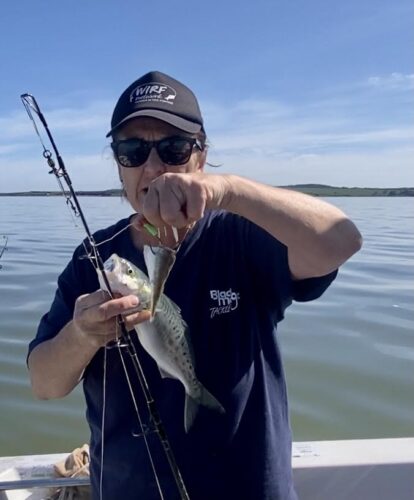
Amanda’s aerodynamic bait presentation
Hook choice varies, but I tend to use circle hooks as they pin the fish in the corner of the mouth- doing less damage to the fish if I want to release them. (As opposed to say a snelled rig for example, which sees the fish often gut hooked and unable to be returned to the water.)
There is a great selection of natural baits to be gathered in Westernport due to the variety of interesting bottom for them to live in. From fresh squid to mackerel, yakkas, trevally, salmon and couta. Get the burley pot going, send some little hooks down in the trail and you will have fresh bait in no time. Plus the bigger fish may follow!
A lot of snapper anglers will also target fresh calamari before they head off to chase a big red! Pilchards and bought squid can also be successful options for targeting bigger fish.
Keep an eye out for birds working as they will often be above a school of salmon. Casting metal lures is a quick and effective way to target them, with salmon strips making a tasty bait for a variety of species.
Soft plastics and jigs can be used to target fish in Westernport, and with some area knowledge and practice will be very productive. They are probably very under utilised compared to bait.
Looking After Westernport
It is essential to preserve the wonderful playground that is Westernport for the generations to come and we can all become marine stewards!
Westernport has some wonderful reef structures like the unique ‘corals’ area and we need to be mindful of this when anchoring. By anchoring off the reef and fishing back onto it you are doing less damage with your anchor and preserving the structure. Consider different anchor designs that do less damage to the seafloor.
Not littering the bay is huge! So many plastics end up in fish and it’s sadly not uncommon to see bait packets on the shoreline. We can also make sure we recycle our rigs and old fishing line and avoid using stainless steel hooks that don’t break down when busted off. Sadly, discarded fishing line ends up harming marine life.
Consider only keeping a feed and putting some of your catch back. That way there will be plenty for our grandkids to catch too!
If you want to go a step further, organisations like OzFish Unlimited undertake lots of great projects to preserve our fishing environment, like mangrove re-seeding. They are always looking for volunteers.
There are lots of simple ways we can all look after the magical, wonderous waterway that is Westernport and enjoy our fishing and boating for years to come!

